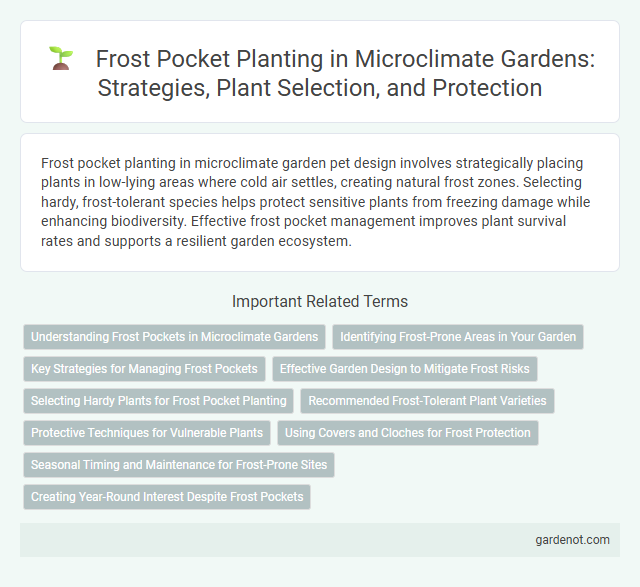Frost pocket planting in microclimate garden pet design involves strategically placing plants in low-lying areas where cold air settles, creating natural frost zones. Selecting hardy, frost-tolerant species helps protect sensitive plants from freezing damage while enhancing biodiversity. Effective frost pocket management improves plant survival rates and supports a resilient garden ecosystem.
Understanding Frost Pockets in Microclimate Gardens
Frost pockets in microclimate gardens occur when cold air settles in low-lying areas, creating zones of increased frost risk that can damage sensitive plants. Understanding the topography and airflow patterns helps gardeners identify these frost-prone pockets, allowing for strategic planting of frost-tolerant species or frost-sensitive plants in elevated or well-drained locations. Effective frost pocket management enhances microclimate resilience and extends the growing season by minimizing frost damage.
Identifying Frost-Prone Areas in Your Garden
Recognizing frost-prone areas in your microclimate garden involves observing low-lying spots where cold air accumulates during the night, often near depressions, valleys, or shaded zones. Soil temperature monitoring and using frost sensors can provide accurate data to pinpoint these frost pockets. Strategic planting in elevated or well-drained locations helps mitigate frost damage and supports plant resilience.
Key Strategies for Managing Frost Pockets
Frost pocket planting requires selecting cold-hardy plant species and situating them in elevated or well-ventilated areas to reduce frost accumulation. Incorporating windbreaks and mulch layers enhances soil warmth and moisture retention, mitigating frost damage. Strategic use of thermal mass, such as rocks or walls, absorbs daytime heat and releases it overnight, protecting sensitive plants in frost-prone microclimates.
Effective Garden Design to Mitigate Frost Risks
Frost pocket planting strategically places frost-sensitive plants in low-risk zones within a microclimate garden, utilizing natural land contours to reduce frost exposure. Incorporating raised beds, windbreaks, and thermal mass elements like stone walls enhances heat retention and air circulation, minimizing frost risks effectively. Site selection near buildings or south-facing slopes further optimizes temperature regulation, safeguarding delicate flora from frost damage.
Selecting Hardy Plants for Frost Pocket Planting
Selecting hardy plants for frost pocket planting involves choosing species with high frost tolerance, such as Heuchera, Sedum, and Hellebores, which thrive in cooler microclimates. These plants exhibit strong resilience to temperature fluctuations and can survive prolonged exposure to cold air settling in low-lying areas. Integrating native perennials and ground covers adapted to frost pockets enhances garden durability and reduces plant loss during early spring frosts.
Recommended Frost-Tolerant Plant Varieties
Recommended frost-tolerant plant varieties for frost pocket planting include hellebores, ornamental kale, and pansies, which can endure temperatures below freezing without damage. Other resilient options are lavender, rosemary, and certain sedum species, known for their ability to thrive in cold, stagnant air conditions typical of frost pockets. Selecting these hardy plants helps create a microclimate garden that remains vibrant despite frost-prone environments.
Protective Techniques for Vulnerable Plants
Frost pocket planting involves situating vulnerable plants in low-lying areas where cold air naturally settles, reducing exposure to damaging frost. Protective techniques include using mulch, frost cloths, or creating physical barriers such as windbreaks to shield plants from harsh temperature fluctuations. Employing these strategies in microclimate gardens enhances plant survival by moderating temperature extremes and minimizing frost damage.
Using Covers and Cloches for Frost Protection
Using covers and cloches in frost pocket planting effectively shields sensitive plants from freezing temperatures by trapping heat and preventing frost formation. Lightweight frost cloths or plastic covers allow sunlight penetration while maintaining warmer air near the plants, reducing frost damage risk. Bell-shaped cloches made of glass or plastic create mini-greenhouse conditions, extending the growing season in microclimate gardens prone to late frosts.
Seasonal Timing and Maintenance for Frost-Prone Sites
Frost pocket planting requires precise seasonal timing, with optimal planting during late spring when soil temperatures consistently rise above 50degF (10degC) to minimize frost damage. Maintenance involves regular mulching to insulate roots, timely pruning to prevent frost injury, and monitoring microclimate conditions such as cold air drainage patterns to protect vulnerable plants. Selecting frost-hardy species and implementing frost protection measures like row covers or windbreaks enhances plant survival in frost-prone garden microclimates.
Creating Year-Round Interest Despite Frost Pockets
Frost pocket planting strategically utilizes microclimate variations to protect sensitive plants in low-lying areas prone to cold air settling. Selecting frost-tolerant species and incorporating layers of diverse vegetation ensures continuous visual appeal and ecological function throughout the seasons. Mulching and positioning plants to maximize sunlight exposure further mitigate frost damage, promoting year-round garden vitality in frost-prone microclimates.
Frost pocket planting Infographic

 gardenot.com
gardenot.com